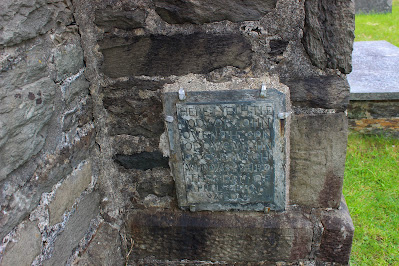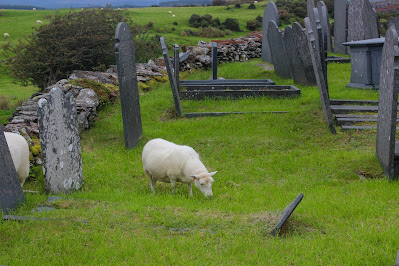But I love other obscure stuff too, and the line between urbex and the non-urbex-but-obscure has been blurry before. Don't worry, this is a renegade tourism blog. I'll never blog about a place with an admission fee. My adventures here will never have me herded through a maze of velvet rope barriers and exiting via the gift shop. I maintain that one of the biggest lies we tell ourselves is that the only meaningful form of recreation costs us money. It doesn't. Go out and do something that makes you happy. After you've read this blog, of course.
The cool thing about this church is that it's pretty isolated. We're on top of a great big hill overlooking an estuary, and it's really peaceful. It's the sort of place one could trek to and encounter minimal humans. I'm a big fan of encountering minimal humans.
The church was founded by St Tecwyn at some point in the 6th Century. Tecwyn travelled from Brittany (or Armorica at the time) to Wales. While Welsh and Breton are pretty different languages, they do share a common ancestor, so back in the 6th Century they were probably a little more mutually intelligible than they are today. And that's quite fortuitous because Tecwyn came here to confabulate, and he came with about thirteen buddies, including his brothers Tanwg and Twrog, and their father's friend Cadfan. Their goal was to promote Christianity in Wales, and they'd all end up sanctified.
Perhaps appropriate for organised religion, the only image I can find of Tecwyn shows him approaching Wales on a petri dish.
(photo not mine)
Initially when he came to the site of this church, there was a big druidic boulder here that had been used for Pagan worship. And like many Christians did with Pagan sites at the time, Tecwyn adopted this spot for his own purposes.
Once Tecwyn began preaching here, people gathered and it slowly became a thriving little community. The first church here was recorded in 1291 but it was replaced with this one in 1879. Despite this, remnants of the predecessor do remain.
This memorial from 1706 was left over from the previous church and just attached to the wall here.
The church interior is really cute. There's nothing much that makes it stand out, but it is very peaceful, and the rows of benches are a bit more comfortable than the standard pew. Not that we've set the bar particularly high there.
The whole absorption of a former Pagan site was actually pretty common among the early Christians. Rather than outright stamp out a rival religion, there was some degree of integration. Plenty of Christian churches are built on old Pagan sites as strategic efforts to facilitate conversion and not piss off the locals by eradicating their ways. They still had their place of worship. It was just a bit more Jesusy now.
We also see this in the appropriation of Pagan holidays. It's this sort of thing that makes it impossible for me, as someone interested in history, to take people seriously if they take Christianity literally. For the first few hundred years, Christians didn't even celebrate birthdays. Birthdays were a Pagan thing. Then all of a sudden, after centuries of not bothering, they decided that they knew when Jesus was born, and it just so happened to be on the winter solstice. How convenient.
This basin is largely thought to be a surviving medieval feature, incorporated into the new church from the old, and it is pretty awesome. Just think how many people have seen and used this since the 1200s.
Having spoken about St Tecwyn and his opulent entourage, it would be remiss of me to not talk about some other aspects of this period in Welsh history that I find pretty interesting. A whole plethora of Welsh locations have names that originate from this point in time. If you've spent any time in Wales you've probably seen or heard of a place that starts with Llan. Llan means Parish, and the rest of the location's name is usually some mutation of a saints name. So to name a couple near me, Llanfyllin evolved from the parish of St Myllin, and Llangedwyn is the parish of St Cedwyn. In the case of Tecwyn, we have Llandecwyn.
The whole concept of saints originated in the Roman times. The Romans outlawed and persecuted Christians, and a lot of them were killed. But as Christianity became more accepted, those who were killed became venerated as martyrs, and eventually sanctified. The original Christian hipsters, who were doing it before it was cool, became saints. This concept exploded across Europe and often their bones were considered holy relics. Holy relics became motivation for pilgrimages, so many churches across Europe would claim to have them. In the later medieval period, there was actually a black market of fake saint remains and religious relics. If you wanted Jesus's foreskin, then good news, you could find ten of them.
When the Romans fucked off out of Britain, Emperor Honorius said "see to your own defences," and that was that. The Romans were gone. For the next few hundred years, the Christians of Britain had no direct contact with Rome, and consequently their rituals and ideas began to change. When it came to pilgrimages the average 6th Century peasant couldn't really travel to Jerusalem or Rome, so they needed closer holy sites.
And the best way to get a closer holy site was with a local saint.
So places in Wales that start with Llan are literally just places where some bloke set up a church. He may well have been a hermit. Hermit saints were all the rage.
These saints probably had some pretty interesting things to say, too. This wasn't the modern Christianity, with grumpy people using Gods name for their own hateful agenda. It was often just some guy, living in a stack of rocks somewhere, that people liked to listen to. These saints pretty much just spread the message of hope, salvation and community, and it was a big hit with the poorer folks. I'm a huge fan of that. Religion should be used to comfort, not persecute.
Quite bizarrely there's some really interesting legends attached to some of these saints. Some of them had random super powers, like talking to animals or seeing the future, and surviving decapitation. Tecwyn's brother Twrog is said to have consumed some "sacred mushrooms," and then hurled a boulder from a mountain to crush a Pagan altar, and it's said that his hand prints are still on that boulder to this day. There's your pilgrimage relic, and your biblical vindication of drug use.
There's a sign here telling about the churches resident bat colony, which is pretty cool. It points out that churches are actually really common roosting spots for bats, and that this is a good thing despite their poop being the bane of the cleaners existence.
I absolutely love bats, but unfortunately I didn't see any.
Quite intriguingly, despite the fact that it's impossible to travel anywhere in Wales without seeing a sign for "Llan-something," there are actually only two Welsh saints who are officially recognised by the Catholic church. That's Saint David and Saint Winifred. Consider that in comparison to how many Llans there are, and it really does highlight how detached the Welsh Christians were after the departure of the Romans. The "cult of saints" just exploded over here, and the Pope just decided that none of it was canon.
In regards to the upkeep of the churchyard, these two are doing a stellar job keeping the grass short.
Despite its relative solitude today, St Tecwyn's church was a popular pilgrimage spot back in the day. A nearby house was actually used as an inn. In the modern era, the view from up here was used for the Windows 10 Snowdonia start up image, but I didn't find that out until after, so I didn't take a comparison shot. Shame on me!
That's about all I've got. St Tecwyn's Church is well worth a mooch if you like cute disused churches. It's probably not going to be on everyone's urbex to-do list, but I liked it. It's just very peaceful up here. There are hundreds of spots in Wales that are just as tranquil, where one can leave the humans to their drama and flappage down below, and just forget the world. That's why Wales is so cool.
My next blog will be some urbex in another new country, and I am very excited to sink my teeth into that.
But if you like my blogs and want to stay updated, then the best way is to follow me on social media. It's a very depressing thing to say, and I don't know how we got to this point as a society. Facebook has recently told me that it's extended my reach because I've been a good boy, which kinda sums up everything that's wrong with social media really. Heaven forbid someone actually sees the output of someone they have willingly chosen to follow. Not all of us are trying to be "influencers." Some of us do just want to do fun things, post about it, and have it be seen by people who want to see it, like the days of the old internet.
If you miss those days, then follow me on the likes of Bluesky, Cara and Vero, social media platforms that aren't algorithmic hellscapes. If you want to stay put and gamble then I have the big shitty three, Twitter, Facebook and Instagram. My reach on Instagram is pretty much non-existent now so as far as getting blog updates go, it's definitely "hard mode." Try it if you like a challenge.
Thanks for reading!


















No comments:
Post a Comment